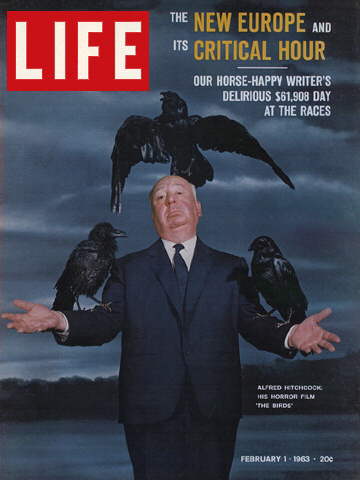
Robin Wood’s thoughtful and penetrating analysis of The Birds in Hitchcock’s Films Revisited is ultimately
disappointing
to me, because I don’t think Wood gets at the thematic heart of the
film, although he does acutely perceive its nature, it’s basic aesthetic
strategy, which is one it shares with all of Hitchcock’s great films —
and I think The Birds is one of Hitchcock’s great films.
The characteristic strategy of The Birds is to lure
the viewer into largely unconscious emotional reactions to images and
situations and then to shift the perceptual ground slightly (or
shockingly, as the case may be) in such a way that the viewer is
compelled to become conflicted about those reactions, consciously or
not.
The goal with Hitchcock is always to heighten moral
and/or spiritual awareness but his methods never involve pronouncements
of any kind, and thus rarely involve symbols than can be reduced to a
precise intellectual meaning. He is only interested in the psychic
currents
which he can tap, appeal to and uncover within the experience of the
viewer as he or she watches the film.
All great artists work this way of course, but if you
think that Hitchcock is just an entertainer, a supplier of sensation
for its own sake, a clever if eccentric practitioner of genre, you will
miss (at least on a conscious level) the full depth of his art.
So when Wood says that the birds in The Birds don’t
symbolize anything specific he is quite correct. But what the birds
do, and when they do it — their function as psychic agents in a
narrative about characters we are alternately drawn to and suspicious
of
— are crucial issues.
The film opens with a man in a pet shop trying,
unsuccessfully, to buy a pair of lovebirds as a gift for his young
sister. In the shop he meets a woman who’s attracted to him, later
buys the pair of lovebirds and drives them up to the remote fishing
village where the man’s sister lives, and leaves them for her. The
film ends with the young sister carrying the birds on an escape through
an apocalyptic landscape — devastated by a lethal revolt . . . of
birds.
What’s going on here? The lovebirds are not symbolic
per se in the artistic scheme of the film — they’re an image that
means different things to different characters at different stages of
the narrative. What’s crucial, it seems to me, is that the lovebirds
are a couple and that they live in a cage. They incarnate a paradox —
are they trapped, or are
they safe? They’re both, obviously — but which condition is most
important? That’s the question the film poses, and answers, after a
fashion.
The woman in the pet shop is an irresponsible heiress
— a bird in a gilded cage, as Wood observes, but alone. When she runs into a man who
wants lovebirds in a cage, she develops what seems to be an irrational
attraction to him. The imagery is very ambiguous here, but suggestive. Is she looking
for company in her cage, a man who’ll share her prison with her?
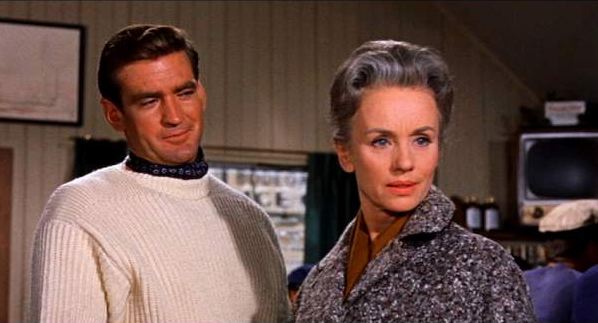
It turns out that the man is the son of a woman who
lost her husband, his father, and is thoroughly traumatized by the
loss. She clings to her son, interferes with his desire to find a
partner of his own — places an intolerable burden on him to become the
head of the family, father to his sister. The mother’s grasping is not
Oedipal, exactly — it’s more a terror of being alone, of being
incomplete. The family’s loss of its father/husband has created a
vacuum in which neurosis breeds.
So the lovebirds, to the man, are an image of the
wholeness he can’t supply — a magical substitution which might allow
him to seek his own wholeness in a new relationship.
The lovebirds may not mean exactly the same thing to
the man and the woman in the pet shop but they crystallize each
other’s
deepest needs and desires. How could they not fall in love in the
presence of such an image?
But the image won’t stay put — won’t stabilize itself
for either of them. Other birds, uncaged birds, gather above them
menacingly. The man catches the woman delivering the lovebirds to his
sister, is
touched, intrigued, drawn to her, as she obviously is to him. At that
moment a seagull attacks the woman, for no apparent reason.
Later, the woman reveals to the man that her mother
deserted her when she was child. At that moment a flock of birds
suddenly attacks the children at the sister’s birthday party. It’s as
though the creatures have emerged demonically from the woman’s ravaged
psyche.
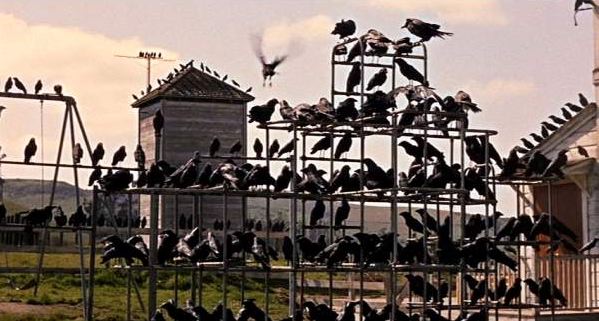
The bird attacks grow more numerous, more lethal, more
surreal. They attack the man and the sister and the mother in their
own home, where the woman is visiting. There seems to be no defense,
no hiding place. But a new family is forming, as the man and the woman
fall deeper and deeper in love, as the sister comes to rely on the
woman emotionally, as the mother slowly softens towards her.
The birds pause in their attack. The family decides
to make a run for it. The sister insists on carrying the lovebirds in
their cage. As they drive away though fields of menacing, roosting,
temporarily placid birds, the mother takes the woman in her arms, in a
mother’s embrace.
The lovebirds in their cage have become a talisman of
salvation — an image of the confinement of commitment, the cage of
family and love, but also of immunity from outright destruction. It’s
like the bait and switch Hitchcock engineered in Shadow Of A Doubt,
where the “oppressive” and suffocating prison of the family, as we see
it at the beginning of the film, is revealed as the only refuge against
forces darker than anyone in that family could ever have imagined.
Only the lovebirds in their cage are free,
provisionally at least. Outside the cage is simply irrational,
meaningless horror. This is not exactly a conservative or romantic
endorsement of committed love and family. Happiness is not really at
stake here, much less moral rectitude or an all-encompassing psychic fulfillment — only
survival. So why is that mother’s embrace at the end of the film so
powerful, so profound, so moving? Because it’s something, set against
nothing.
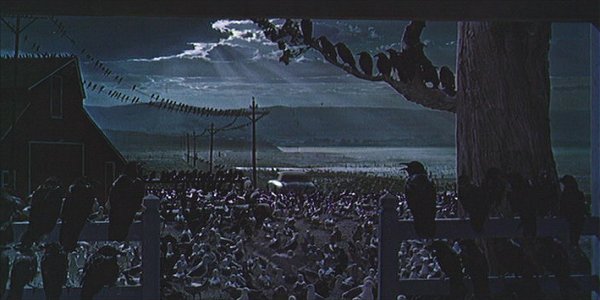
The newly constructed family drives off jammed into a
small sports car, caged. They incarnate a paradox — are they trapped,
or are they safe? Both,
obviously — but which condition is most important? It’s clear enough
which way the film leans on this issue, but Hitchcock isn’t making any
promises. He insisted that “The End” not appear at the film’s close —
partly as a gimmick (“The birds are still out there!”), partly to keep
the psychic and moral tension alive in the audience . . . but also
partly, no doubt, because he knew subconsciously that he would return
to the female protagonist of this film again, would explore her
existential jeopardy in greater depth, which he did in Marnie, using the
same actress, playing a very similar lost soul in search of a mother’s
embrace.
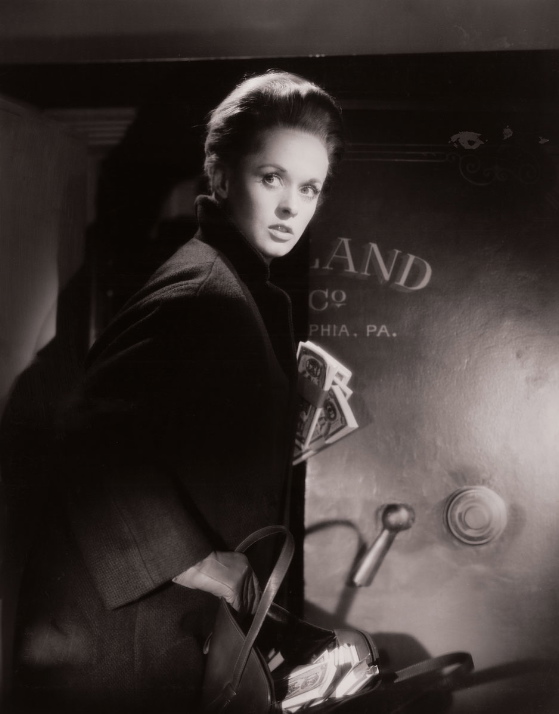
The hidden, poisoned springs of many Hitchcock films run through the
pathology of dysfunctional parents, shattered, perverted families,
wrecked marriages — and the provisional redemption these films offer
often involves new families reconstructed on the ruins of old
ones. Hitchcock’s view of the family, all families, was ambiguous
— and his passionate defense of the family as a bastion against
terror, against meaninglessness, was inflected by this ambiguity.
Even so, his view was inaccessible to many critics, like Wood, who
were, for personal and political reasons, deeply suspicious of the
family as a social phenomenon — an attitude that became fashionable,
almost a matter of faith, among 20th-Century intellectuals. Wood
wanted to analyze The Birds
as a vision merely of conflict between order and disorder, missing the
fact that, for Hitchcock, this conflict was centrally bound up with the
idea of family.
Hitchcock was canny. He knew that society cannot face its deepest
concerns, its deepest fears, directly. He knew that those fears
had to be displaced in art, given an indirect expression — blamed, as
it were, on the birds.
